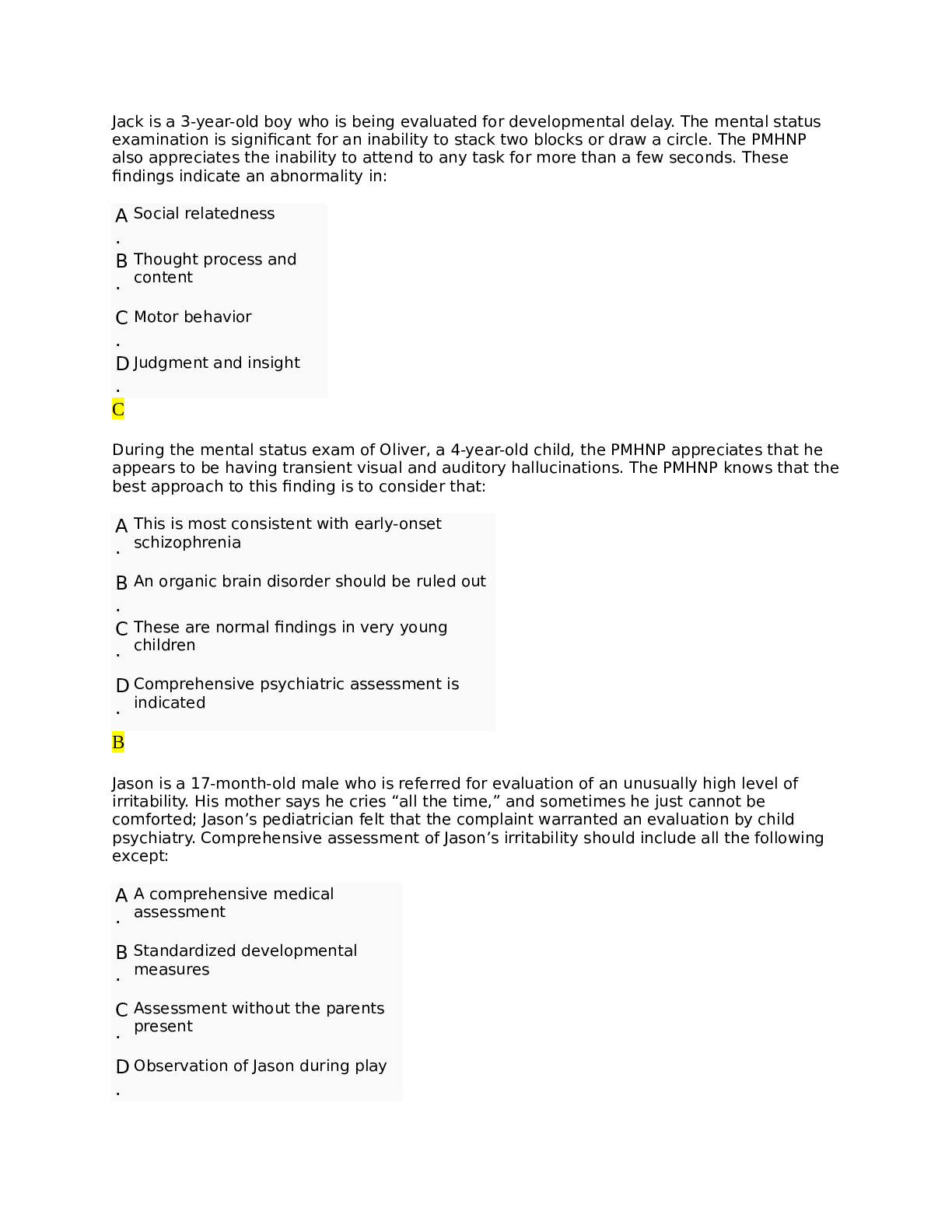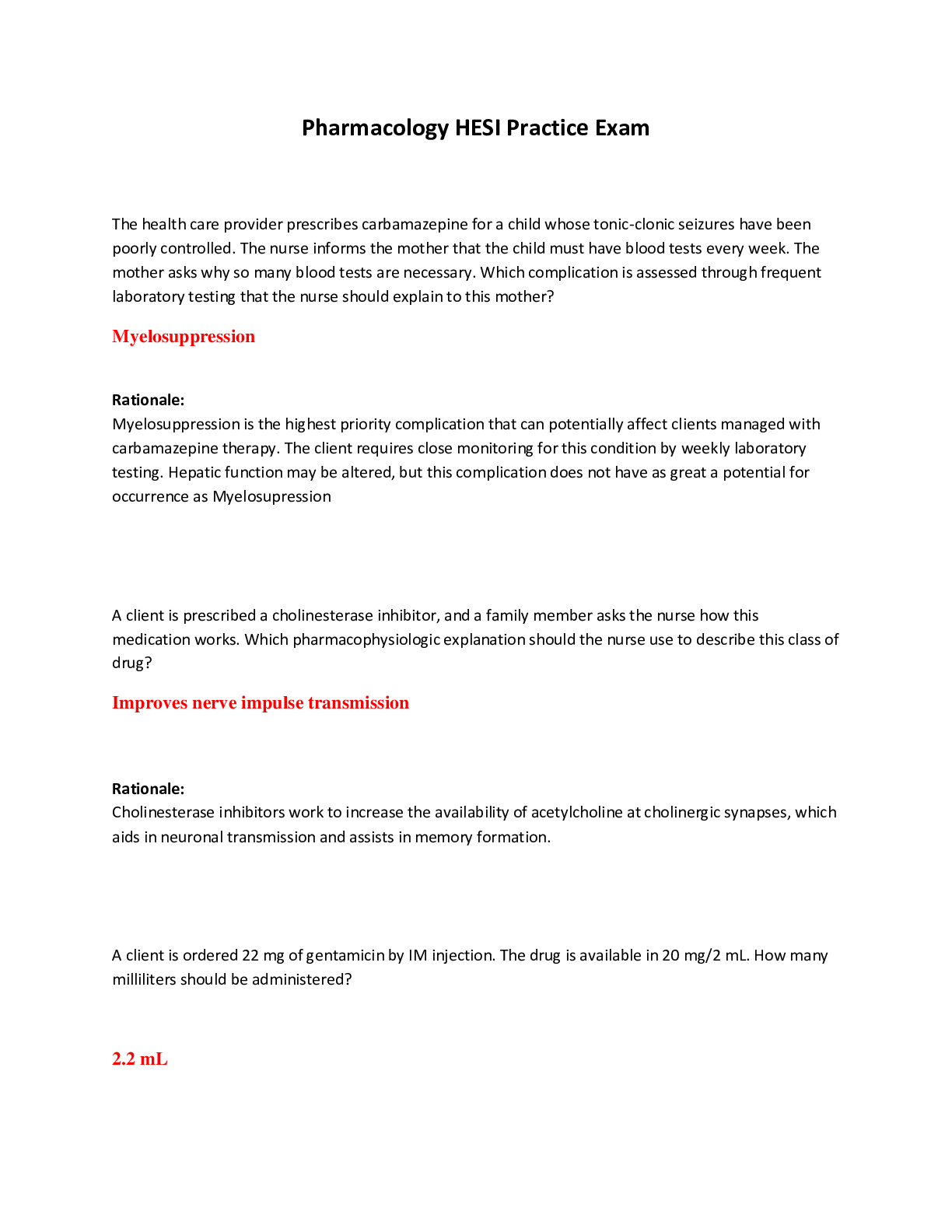*NURSING > QUESTIONS & ANSWERS > Pathophysiology Exam 3 Practice Questions and Answers Latest 2022 Update (Complete test bank) (All)
Pathophysiology Exam 3 Practice Questions and Answers Latest 2022 Update (Complete test bank)
Document Content and Description Below
Pathophysiology Exam 3 Practice Questions and Answers Latest 2022 Update (Complete test bank) The nurse working in an outpatient nephrology clinic knows that which of the following are primary func... tions of the kidneys? (Select all that apply.) A. Production of clotting factors B. Homeostasis C. Excretion of metabolic wastes D. Regulation of acid-base balance E. Metabolism of fats Correct Answer- B, C, D The kidneys do not metabolize fats. Production of clotting factors is a primary function of the liver. The kidneys maintain blood pressure using the RAAS and also produce erythropoietin to stimulate RBC production. In caring for a patient diagnosed with acute kidney injury, the nephrology nurse knows that which of the following tests are specific for renal function? (Select all that apply.) A. Aspartate aminotransferase (AST) B. Blood urea nitrogen C. Creatinine D. Glomerular filtration rate E. White blood cell count Correct Answer- B, C, D AST related to LIVER function In caring for a patient with acute kidney injury the nurse knows that the patient's renal function has returned to normal range when the patient's GFR measures: A. 30-40 mL/min B. 40-50 mL/minC. 70-90 mL/min D. 90-120 mL/min Correct Answer- D Normal GFR is 90-120 mL/min Normal Creatinine 0.6-1.1 for females and 0.6-1.2 for males Normal BUN is 10-20 mg/dL *Be sure to know these normal values, you will use them daily as a nurse The nursing working in a geriatric living facility understands that as patients age, which change in glomerular filtration rate is expected? A. Increased GFR B. Decreased GFR C. Same GFR D. No GFR Correct Answer- B Aging and renal function: Decrease in renal blood flow and GFR → altered sodium and water balance Number of nephrons decrease due to renal vascular and perfusion changes Response to acid-base changes is delayed Increased risk for drug toxicity Alterations in thirst and water intake Get dehydrated very easily; do not recognize thirst and heat Decreased muscle mass may lead to decreased creatinine values An older patient is experiencing urinary stasis. The registered nurse knows that urinary stasis may lead to which of the following? A. Increased GFR B. HypocoagulationC. Hypertension D. Infection Correct Answer- D Urinary stasis is a risk factor for developing UTI Which of the following is classified as the most common primary mineral salt composition of kidney stones? A. Calcium B. Struvite C. Uric Acid D. Cysteine Correct Answer- A A - calcium (i.e. oxalate or phosphate) is most common *Note that a change in urine pH may lead to precipitation of stones Which of the following are risk factors for developing renal tumors? (Select all that apply.) A. Female gender B. Smoking C. Obesity D. Diabetes E. Hypertension Correct Answer- B, C, E risk factors are male gender, smoking, obesity, uncontrolled hypertension The registered nurse would expect which of the following lab values for a patient experiencing acute kidney failure? A. Creatinine 3.5 mg/dL B. Sodium 122 mEq/LC. Albumin 3.5 g/dL D. BUN 10 mg/dL Correct Answer- A the normal creatinine level is 0.6 - 1.2 This BUN is within normal range (BUN would be elevated in acute kidney failure) In caring for a patient experiencing acute kidney injury who has these lab values: urinary output 15 mL/hr, BUN 30 mg/dL, and creatinine 3.5, the nurse knows that the patient is experiencing which phase of acute kidney injury? A. Initiation phase B. Oliguric phase C. Recovery (polyuric) phase D. I don't remember the normal lab values Correct Answer- B Remember that there are phases of acute kidney injury - Initiation phase is when the injury is just beginning and prevention is still possible Next is the oliguric phase where urinary output is decreased and nitrogenous waste products are maintained (BUN and Creatinine) There is also the recovery or polyuric/diuretic phase - diuresis is common and BUN and creatinine decline A 25-year-old female is diagnosed with urinary tract obstruction. While planning care, the nurse realizes that the patient is expected to have hydronephrosis and a decreased glomerular filtration rate caused by: A. Decreased renal blood flow B. Decreased peritubular capillary pressure C. Dilation of renal pelvis and calyces proximal to blockage D. Stimulation of antidiuretic hormone Correct Answer- CHydroureter; dilation of ureter Hydronephrosis: dilation/enlargement of renal pelvis and calyces Ureterohydronephrosis: dilation of ureter AND renal pelvis and calyces A 55-year-old male presents reporting urinary retention. Tests reveal that he has a lower urinary tract obstruction. Which of the following is of most concern to the nurse? A. Vesicoureteral reflux and pyelonephritis B. Formation of renal calculi C. Glomerulonephritis D. Increased bladder compliance Correct Answer- B urine stasis occurs with urinary tract obstruction and can lead to the formation of renal calculi and UTI A 75-year-old male reports to his primary care provider loss of urine with cough, sneezing, or laughing. Which of the following is the most likely diagnosis the nurse will observe on the chart? A. Urge incontinence B. Overflow incontinence C. Stress incontinence D. Functional incontinence Correct Answer- C Reduced resistance is associated with the symptom of stress incontinence, which is incontinence with coughing or sneezing. A 29-year-old female presents with cloudy urine, flank pain, hematuria, and fever. Which of the following does the nurse suspect the patient is most likely experiencing? A. Acute cystitis B. Renal calculi C. Chronic renal failure D. Postrenal renal failure Correct Answer- Aacute cystitis is infection/inflammation of bladder (UTI) Although renal calculi can cause pain and hematuria, it is not manifested by fever and cloudy urine. A 30-year-old male is demonstrating hematuria with red blood cell casts and proteinuria exceeding 3 to 5 g/day, with albumin being the major protein. The most probable diagnosis the nurse will see documented on the chart is: A. Cystitis B. Chronic pyelonephritis C. Acute glomerulonephritis D. Renal calculi Correct Answer- C Two major symptoms distinctive of more severe glomerulonephritis are: hematuria with red blood cell casts (2) proteinuria exceeding 3 to 5 g/day with albumin (macroalbuminuria) as the major protein A 54-year-old female is diagnosed with nephrotic syndrome. Which of the following is a common symptom of this disease? A. Hematuria B. Dysuria C. Oliguria D. Proteinuria Correct Answer- D Nephrotic syndrome is manifested by proteinuria Nephrotic syndrome is diagnosed when the protein level in a 24-hour urine collection is greater than 3.5 g A 56-year-old male presents with flank pain and polyuria. Tests reveal that he has an enlarged prostate. Which of the following types of renal failure should the nurse monitor for as it is the most likely to occur? A. PrerenalB. Intrarenal C. Extrarenal D. Postrenal Correct Answer- D the patient will experience postrenal renal failure due to obstruction by the prostate. What if the test revealed acute tubular necrosis? intrarenal While turning a patient with chronic renal failure, which principle should the nurse recall? Bone fractures are a risk factor in chronic renal failure because: A. Calcium is lost in the urine B. Osteoblast activity is excessive C. The kidneys fail to activate vitamin D D. Autoantibodies to calcium molecules develop Correct Answer- C Hypocalcemia is accelerated by impaired renal synthesis of vitamin D The combined effect of vitamin D deficiency can result in renal osteodystrophies with increased risk for fractures. A man was mildly confused, and his family brought him to adult day care during the week. He was incontinent there every day until a nurse suggested that they put a picture of a toilet on the bathroom door, and he became continent. What incontinence is this? Correct Answer- Functional Incontinence A woman has a bladder infection and is distressed to have episodes of sudden strong need to urinate that cause her to become incontinent. What incontinence is this? Correct Answer- Urge Incontinence A woman loses a small amount of urine involuntarily every time she sneezes. What incontinence is this? Correct Answer- Stress IncontinenceA man with a caudal equine involvement in MS became incontinent when his caregiver was late and was not available to assist with the morning catheterization. What incontinence is this? Correct AnswerOverflow Incontinence A 50-year-old male is experiencing reflux of chyme from the stomach. He is diagnosed with gastroesophageal reflux. This condition is caused by: A. Fibrosis of lower third of esophagus B. Sympathetic nerve stimulation C. Loss of muscle tone at the lower esophageal sphincter D. Reverse peristalsis of the stomach Correct Answer- C GERD is due to a weak esophageal sphincter A 22-year-old male underwent brain surgery to remove a tumor. Following surgery, he experienced a peptic ulcer. His ulcer is referred to as a(n) _____ ulcer. A. Infectious B. Cushing C. Ischemic D. Curling Correct Answer- B Cushing ulcer is a stress ulcer associated with severe head trauma or brain surgery. Curling ulcers develop secondary to burns. A 50-year-old male complains of frequently recurring abdominal pain, diarrhea, and bloody stools. A possible diagnosis would be: A. Ulcerative colitis B. Hiatal hernia C. Pyloric obstruction D. Achalasia Correct Answer- AUlcerative colitis is manifested by fever, elevated pulse rate, frequent diarrhea (10 to 20 stools/day), urgency, obviously bloody stools, and continuous lesions present in the colon. Hiatal hernia is most often asymptomatic and would not be manifested by abdominal pain. Pyloric obstruction would be manifested by forceful or projectile vomiting. Achalasia would be manifested by difficulty or uncomfortable swallowing. A 16-year-old female presents with abdominal pain in the right lower quadrant. Physical examination reveals rebound tenderness and a low-grade fever. A possible diagnosis would be: A. Colon cancer B. Pancreatitis C. Appendicitis D. Hepatitis Correct Answer- C Appendicitis is manifested by RLQ pain with rebound tenderness. A 54-year-old male complains that he has been vomiting blood. Tests reveal portal hypertension. Which of the following is the most likely cause of his condition? A. Thrombosis in the spleen B. Cirrhosis of the liver C. Left ventricular failure D. Renal stenosis Correct Answer- B Portal hypertension occurs secondarily to cirrhosis of the liver. Manifestations associated with hepatic encephalopathy from chronic liver disease are the result of: A. Hyperbilirubinemia and jaundice B. Fluid and electrolyte imbalances C. Impaired ammonia metabolism D. Decreased cerebral blood flow Correct Answer- CImpaired ammonia metabolism leads to the symptoms of hepatic encephalopathy. The icteric phase of hepatitis is characterized by which of the following clinical manifestations? A. Fatigue, malaise, vomiting B. Jaundice, dark urine, enlarged liver C. Resolution of jaundice, liver function returns to normal D. Fulminant liver failure, hepatorenal syndrome Correct Answer- B The icteric phase is manifested by jaundice, dark urine, and clay-colored stools The liver is enlarged, smooth, and tender, and percussion causes pain; this is the actual phase of illness. A 55-year-old male died in a motor vehicle accident. Autopsy revealed an enlarged liver caused by fatty infiltration, testicular atrophy, and mild jaundice secondary to cirrhosis. The most likely cause of his condition is: A. Bacterial infection B. Viral infection C. Alcoholism D. Drug overdose Correct Answer- C The most common cause of cirrhosis is alcoholism. While caring for a patient on a med-surg floor, the nurse notes the presence of bright red stools. How does the nurse document this finding? A. Melena B. Hematochezia C. Hematemesis D. Occult bleeding Correct Answer- B Melena is black tarry stoolsOccult bleeding is where there are broken down products of blood are present in the stool While reading a patient's diagnostic evaluation, the nurse notes that the patient's GI tract has a cobblestone appearance. This is present in which disorder? A. Ulcerative colitis B. Irritable bowel disease C. Crohn disease D. Infective enterocolitis Correct Answer- C Note also that ulcerative colitis is confined to the colon or rectum Crohn's disease may occur in various sites of GI tract While reading the patient's diagnostic evaluation, the nurse reads that the patient has experienced a twisting of the bowel. This type of obstruction is known as: A. Volvulus B. Intussusception C. Hernia D. Adhesion Correct Answer- A In caring for a patient experiencing liver failure, which of the following lab values does the nurse expect to be elevated? (Select all that apply.) A. Aspartate Aminotransferase (AST) B. Alanine Aminotransferase (ALT) C. Albumin D. Ammonia E. Bilirubin Correct Answer- A, B, D, E Albumin would be decreasedA teenage boy sustains a severe closed head injury following an all-terrain vehicle (ATV) accident. He is in a state of deep sleep that requires vigorous stimulation to elicit eye opening. How should the nurse document this in the chart? A. Confusion B. Coma C. Obtundation D. Stupor Correct Answer- D Stupor is a condition of deep sleep or unresponsiveness from which the person may be aroused or caused to open eyes only by vigorous and repeated stimulation. When thought content and arousal level are intact but a patient cannot communicate, the patient has: A. Cerebral death B. Locked-in syndrome C. Dysphagia D. Cerebellar motor syndrome Correct Answer- B Locked-in syndrome occurs when the individual cannot communicate through speech or body movement but is fully conscious, with intact cognitive function A 65-year-old male recently suffered a cerebral vascular accident. He is now unable to recognize and identify objects by touch because of injury to the sensory cortex. How should the nurse document this finding? A. Hypomimesis B. Agnosia C. Dysphasia D. Echolalia Correct Answer- B Agnosia is the failure to recognize the form and nature of objectsA nurse thinks a patient may be experiencing dementia. Which assessment finding will most help support this diagnosis? A. Violent behavior B. Hyperactivity C. Depression D. Loss of recent and remote memory Correct Answer- D Dementia is characterized by loss of recent and remote memory. The patient is experiencing an increase in intracranial pressure. This increase results in: A. Brain tissue hypoxia B. Intracranial hypotension C. Ventricular swelling D. Expansion of cranial vault Correct Answer- A Brain tissue hypoxia occurs as a result of increased intracranial pressure as it places pressure on the brain A 51-year-old male is admitted to the neuro ICU with a severe closed head injury. All four extremities are in rigid extension, his forearm is hyperpronated, and his legs are in plantar extension. How should the nurse chart this condition? A. Decorticate posturing B. Decerebrate posturing C. Caloric posturing D. Excitation posturing Correct Answer- B A 20-year-old male is admitted to the neurological critical care unit with a severe closed head injury. When an intraventricular catheter is inserted, the ICP is recorded at 24 mm Hg. How should the nurse interpret this reading? This reading is: A. Higher than normal B. Lower than normalC. Normal D. Borderline Correct Answer- A Normal ICP is 1 to 15 mm Hg A patient has paralysis of both legs. What type of paralysis does the patient have? A. Paraplegia B. Quadriplegia C. Infraparaplegia D. Paresthesia Correct Answer- A A patient has excessive movement. What disorder will the nurse see documented on the chart? A. Hypokinesia B. Akinesia C. Hyperkinesia D. Dyskinesia Correct Answer- C Which principle should the nurse remember while planning care for a patient with spinal shock? Spinal shock is characterized by: A. Loss of voluntary motor function with preservation of reflexes B. Cessation of spinal cord function below the lesion C. Loss of spinal cord function at the level of the lesion only D. Temporary loss of spinal cord function above the lesion Correct Answer- B Spinal shock is the complete cessation of spinal cord function below the lesion A 40-year-old male complains of uncontrolled excessive movement and progressive dysfunction of intellectual and thought processes. He is experiencing movement problems that begin in the face and arms that eventually affect the entire body. The most likely diagnosis is: A. Tardive dyskinesiaB. Huntington disease C. Hypokinesia D. Alzheimer disease Correct Answer- B Huntington disease is manifested by chorea, abnormal movement that begins in the face and arms, eventually affecting the entire body - Progressive dysfunction of intellectual and thought processes A nurse is preparing to teach staff about the most common type of traumatic brain injury. Which type of traumatic brain injury should the nurse discuss? A. Penetrating trauma B. Diffuse axonal injury C. Focal brain injury D. Concussion Correct Answer- D Which assessment finding by the nurse characterizes a mild concussion? A. A brief loss of consciousness B. Significant behavioral change C. Retrograde amnesia D. Permanent confusion Correct Answer- C Mild concussion is characterized by immediate but transitory confusion that lasts for one to several minutes, possibly with amnesia for events preceding the trauma. brief loss of consciousness may occur with classic concussion More severe DIAs may induce behavioral changes Confusion will be temporary with mild concussion An initial assessment finding associated with acute spinal cord injury is _____ the injury. A. Pain below the level ofB. Loss of autonomic reflexes above C. Loss of voluntary control below D. Hyperactive spinal reflexes below Correct Answer- C Six weeks ago a female patient suffered a T6 spinal cord injury. She then developed a blood pressure of 200/120, a severe headache, blurred vision, and bradycardia. What does the nurse suspect the patient is experiencing? A. Extreme spinal shock B. Acute anxiety C. Autonomic hyperreflexia D. Parasympathetic areflexia Correct Answer- C A 72-year-old male demonstrates left-sided weakness of upper and lower extremities. The symptoms lasted 4 hours and resolved with no evidence of infarction. The patient most likely experienced a(n): A. Stroke in evolution B. AV malformation C. Transient ischemic attack D. Cerebral hemorrhage Correct Answer- C When symptoms resolve with complete recovery, it is a transient ischemic attack A 60-year-old female with a recent history of head trauma and a long-term history of hypertension presents to the ER for changes in mental status. MRI reveals that she had a hemorrhagic stroke. What does the nurse suspect caused this type of stroke? A. Rheumatic heart disease B. Thrombi C. Hypotension D. Aneurysm Correct Answer- D The primary causative factor of a hemorrhagic stroke is an aneurysm.A 25-year-old female presents to her primary care provider reporting fever, headache, nuchal rigidity, and decreased consciousness. She was previously treat [Show More]
Last updated: 1 year ago
Preview 1 out of 40 pages
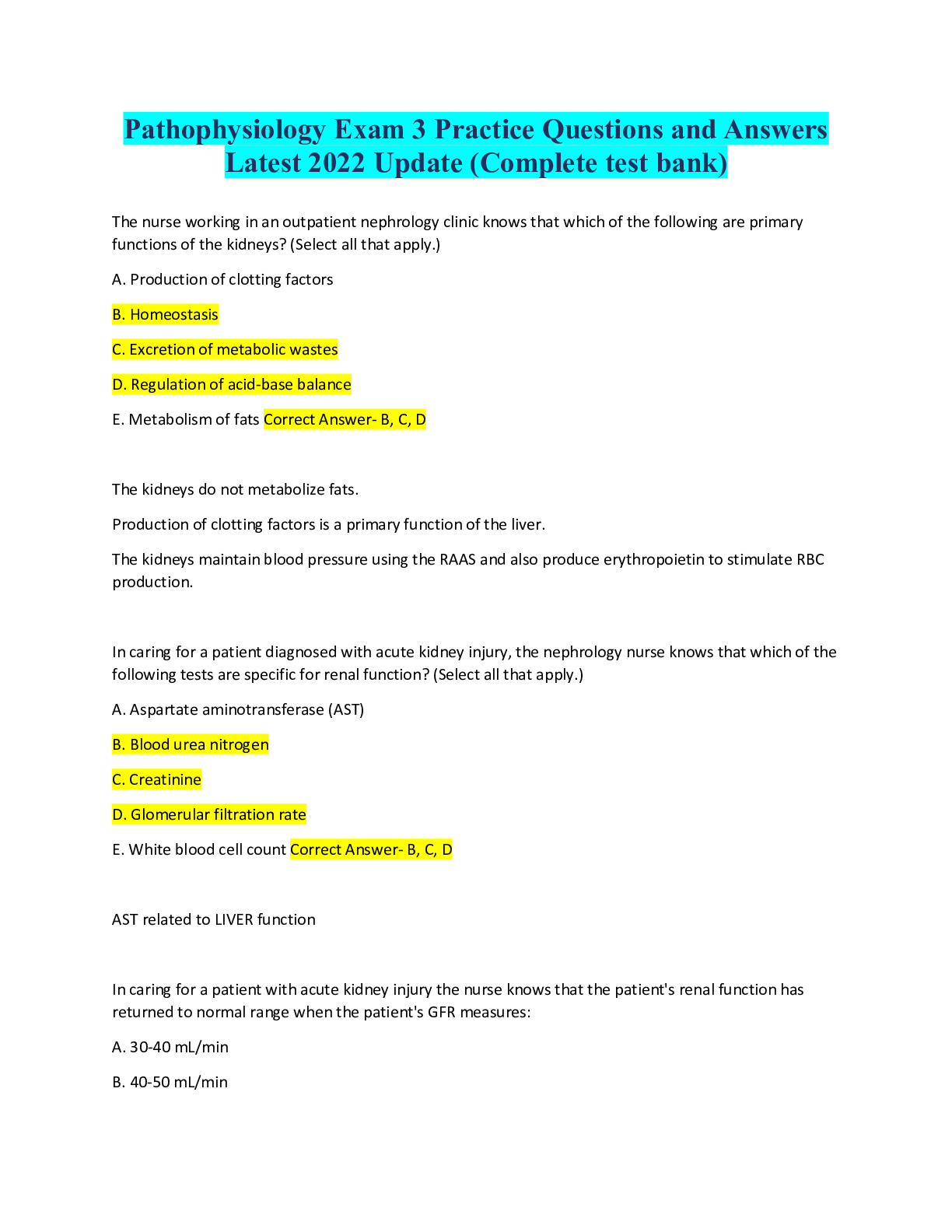
Buy this document to get the full access instantly
Instant Download Access after purchase
Add to cartInstant download
We Accept:

Reviews( 0 )
$5.00
Document information
Connected school, study & course
About the document
Uploaded On
Sep 02, 2022
Number of pages
40
Written in
Additional information
This document has been written for:
Uploaded
Sep 02, 2022
Downloads
0
Views
86


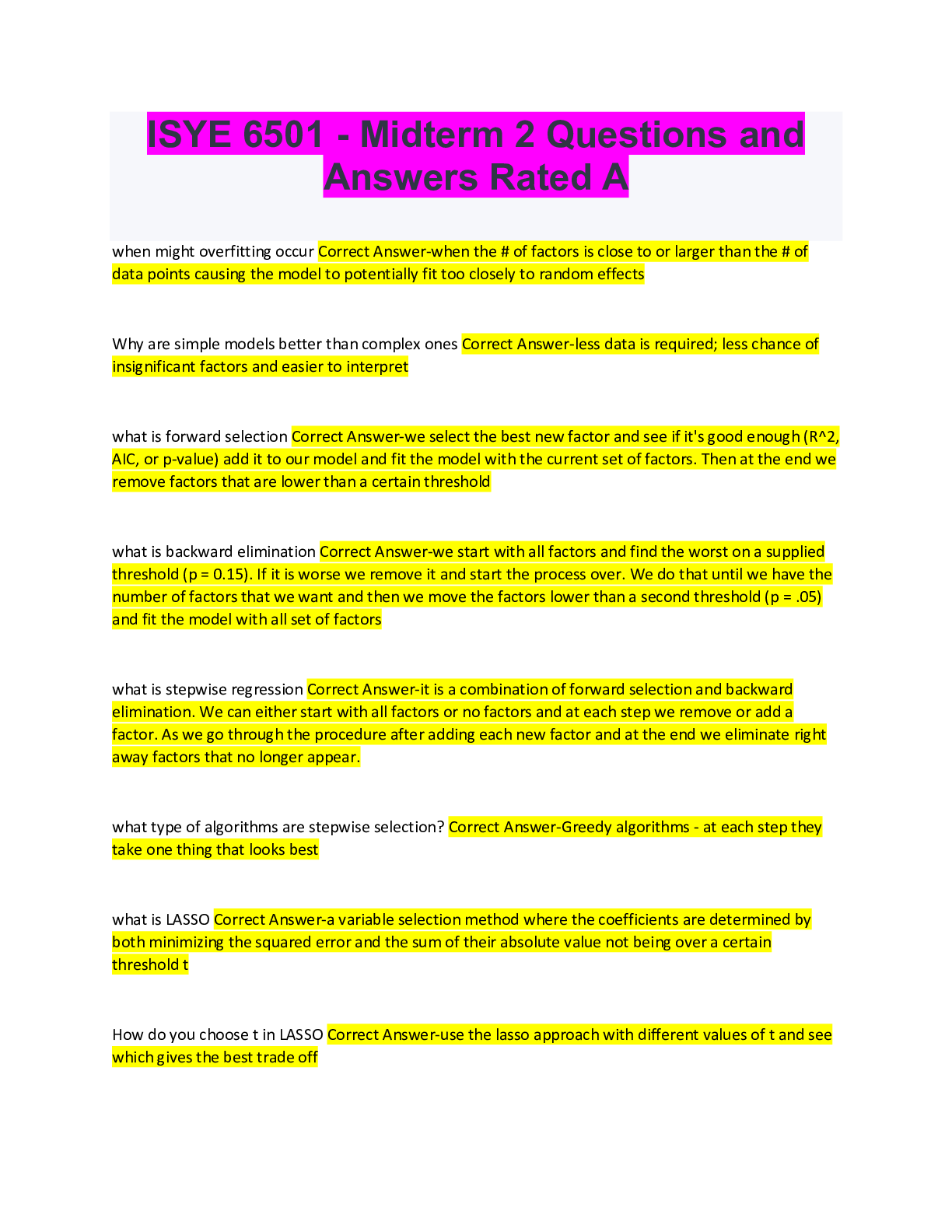









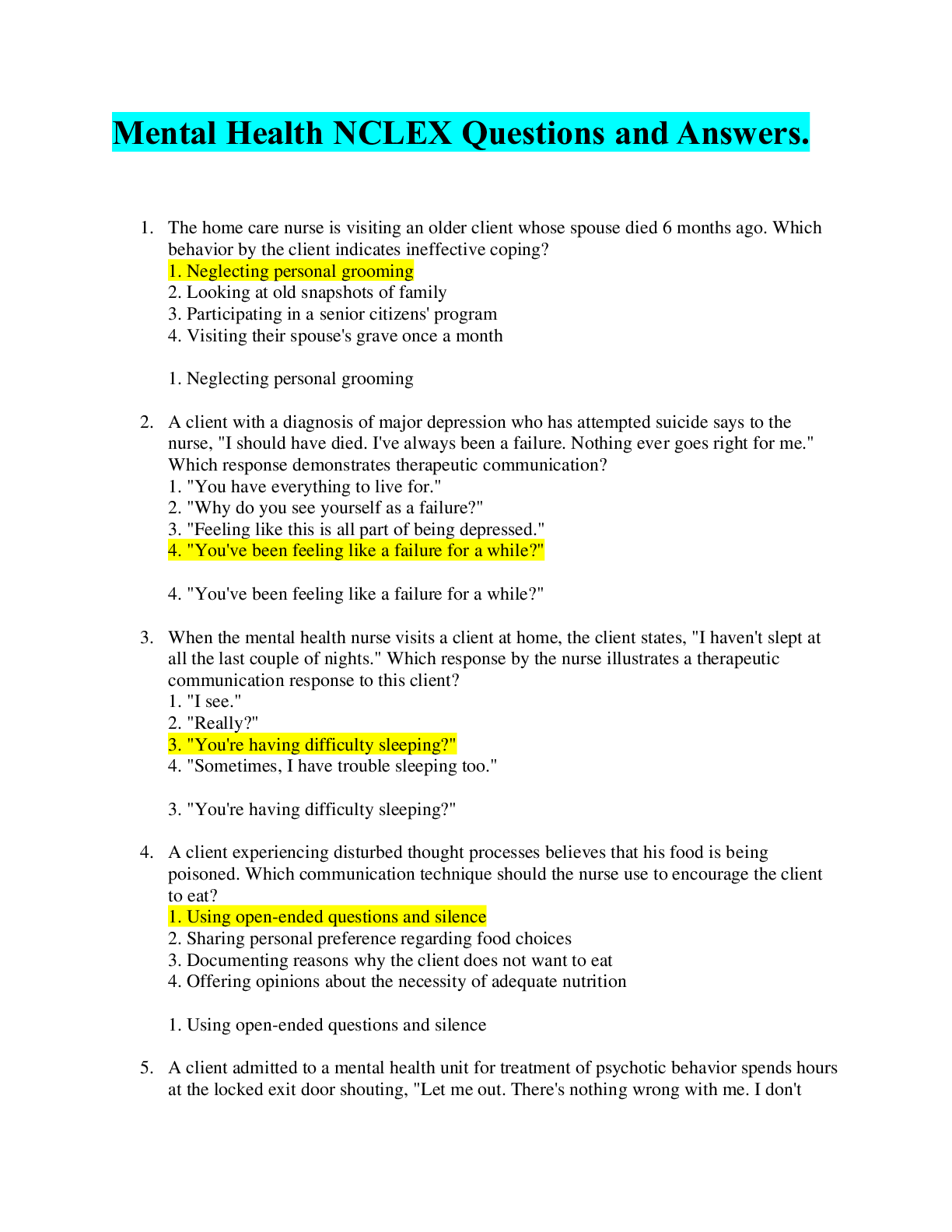
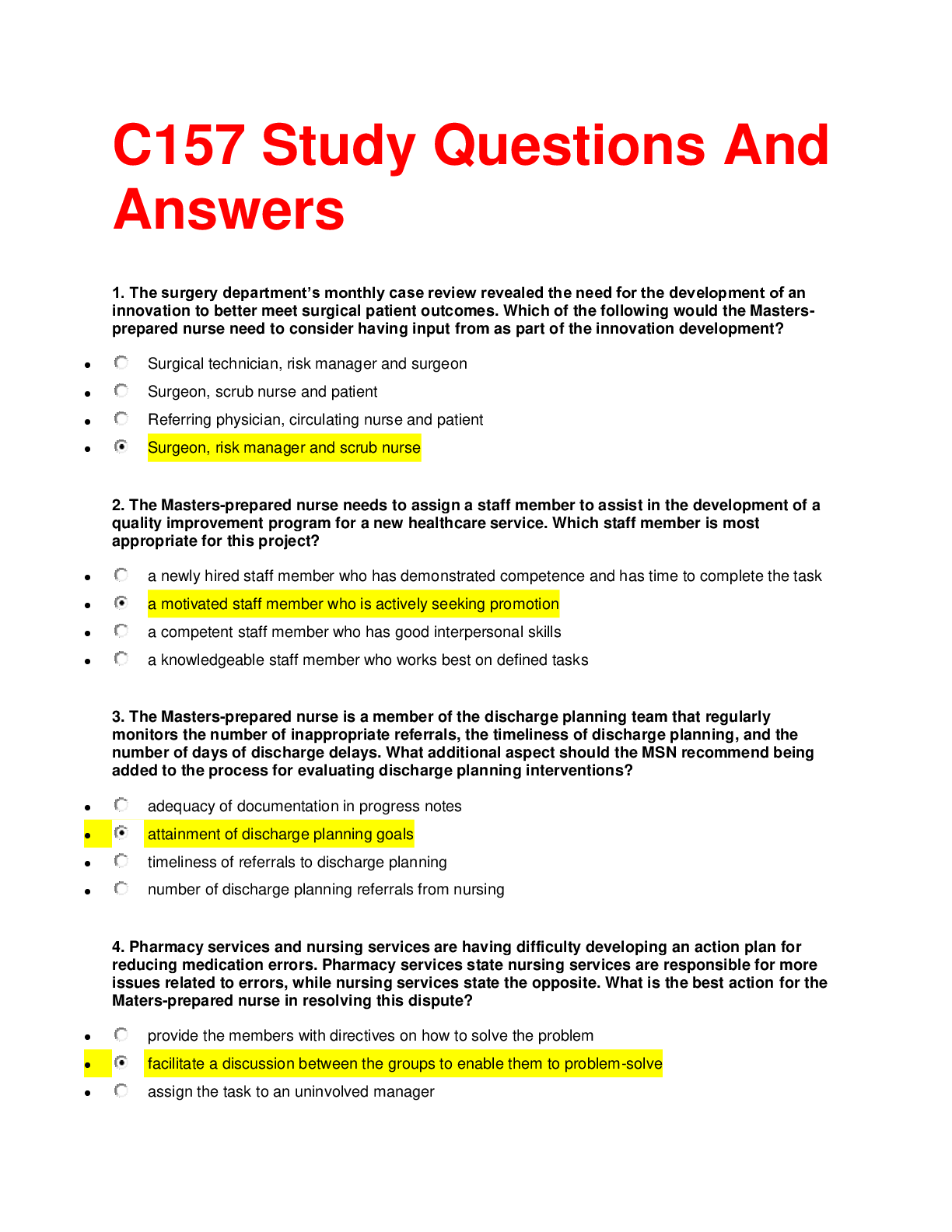
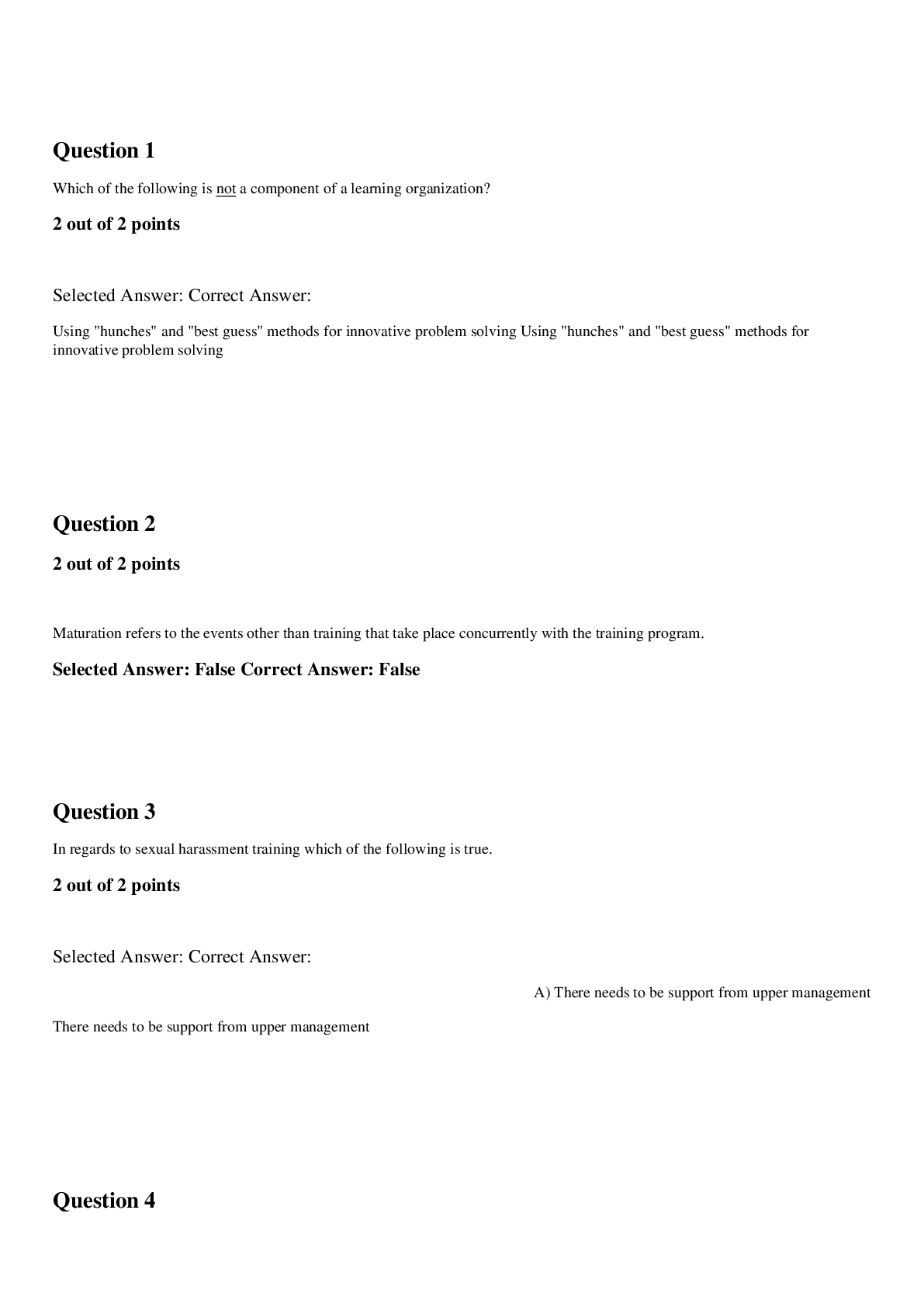

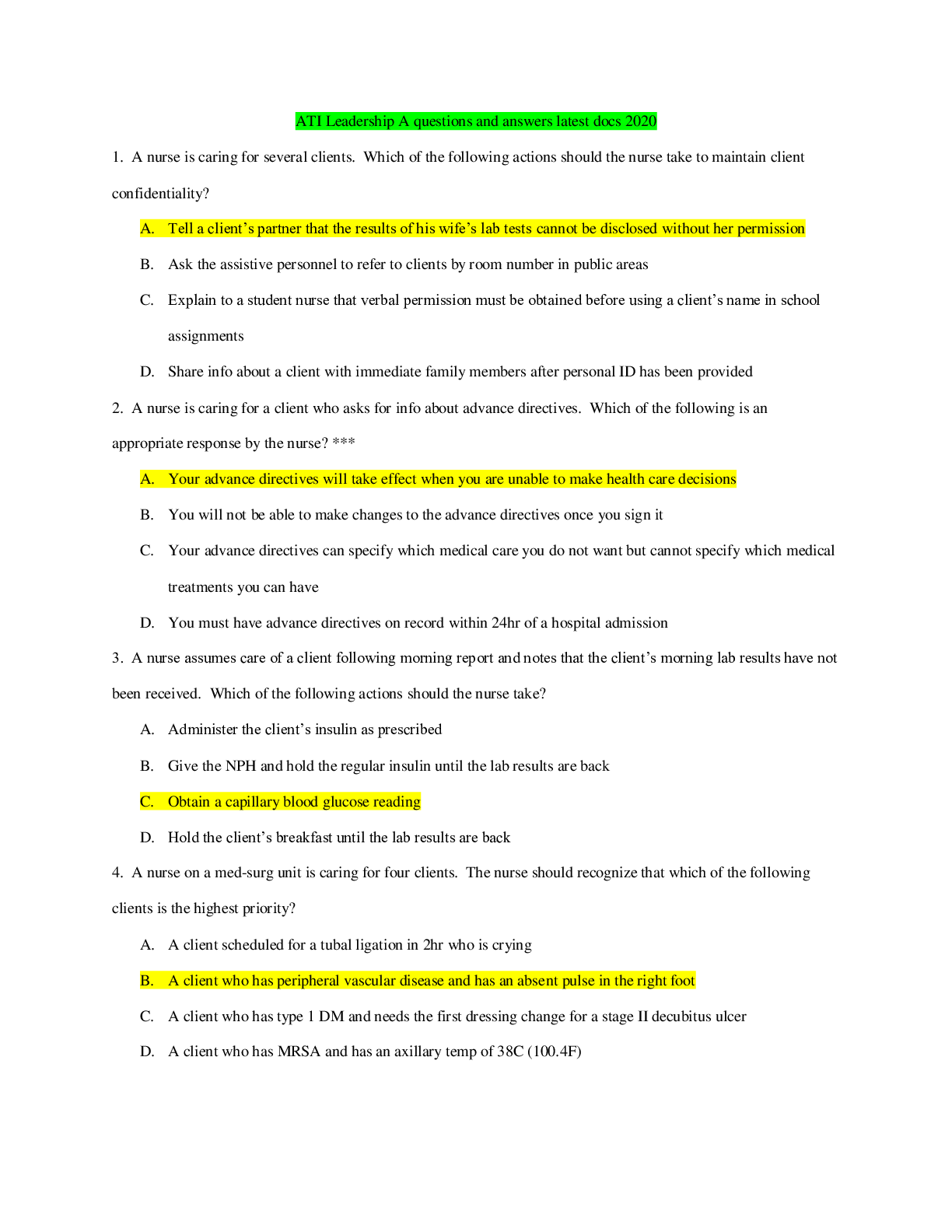
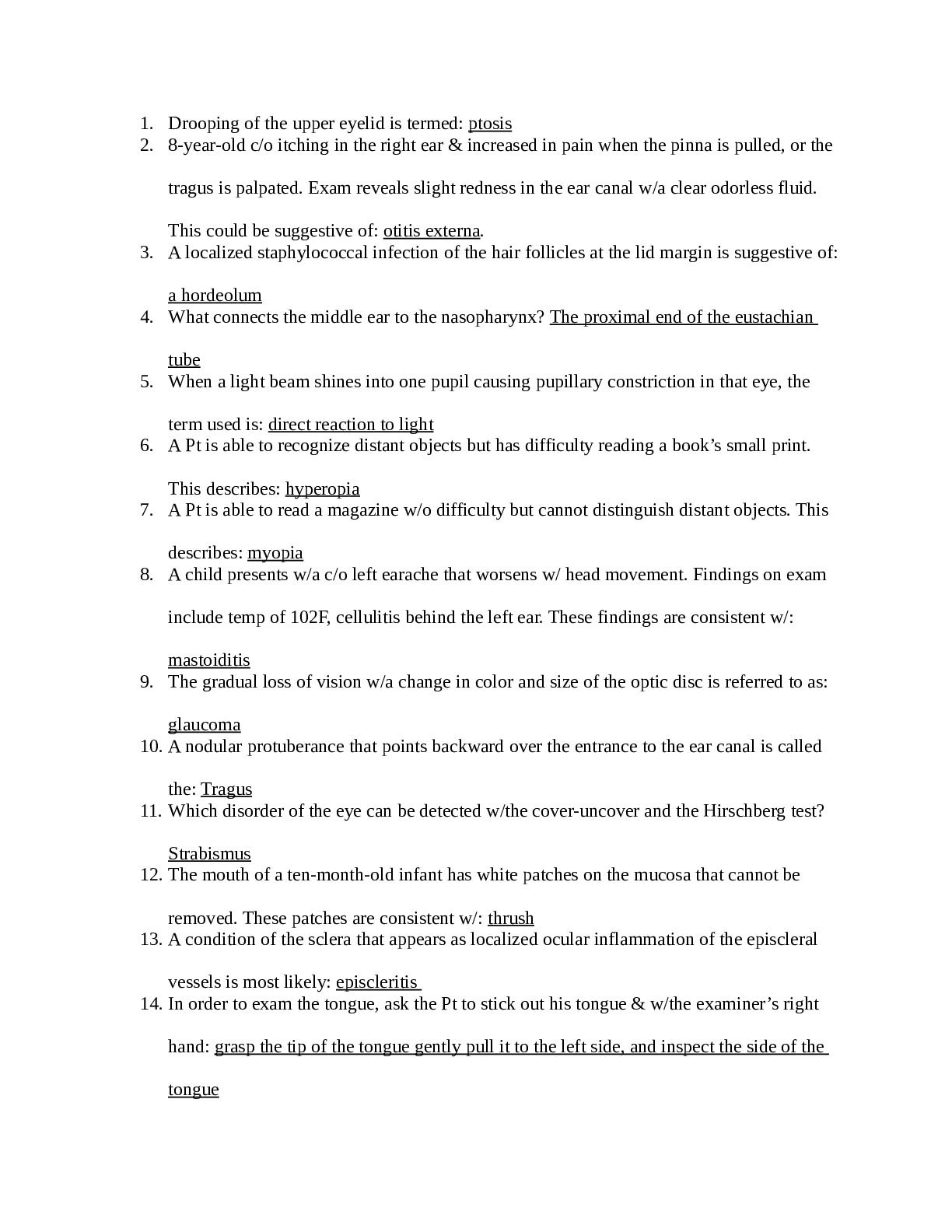


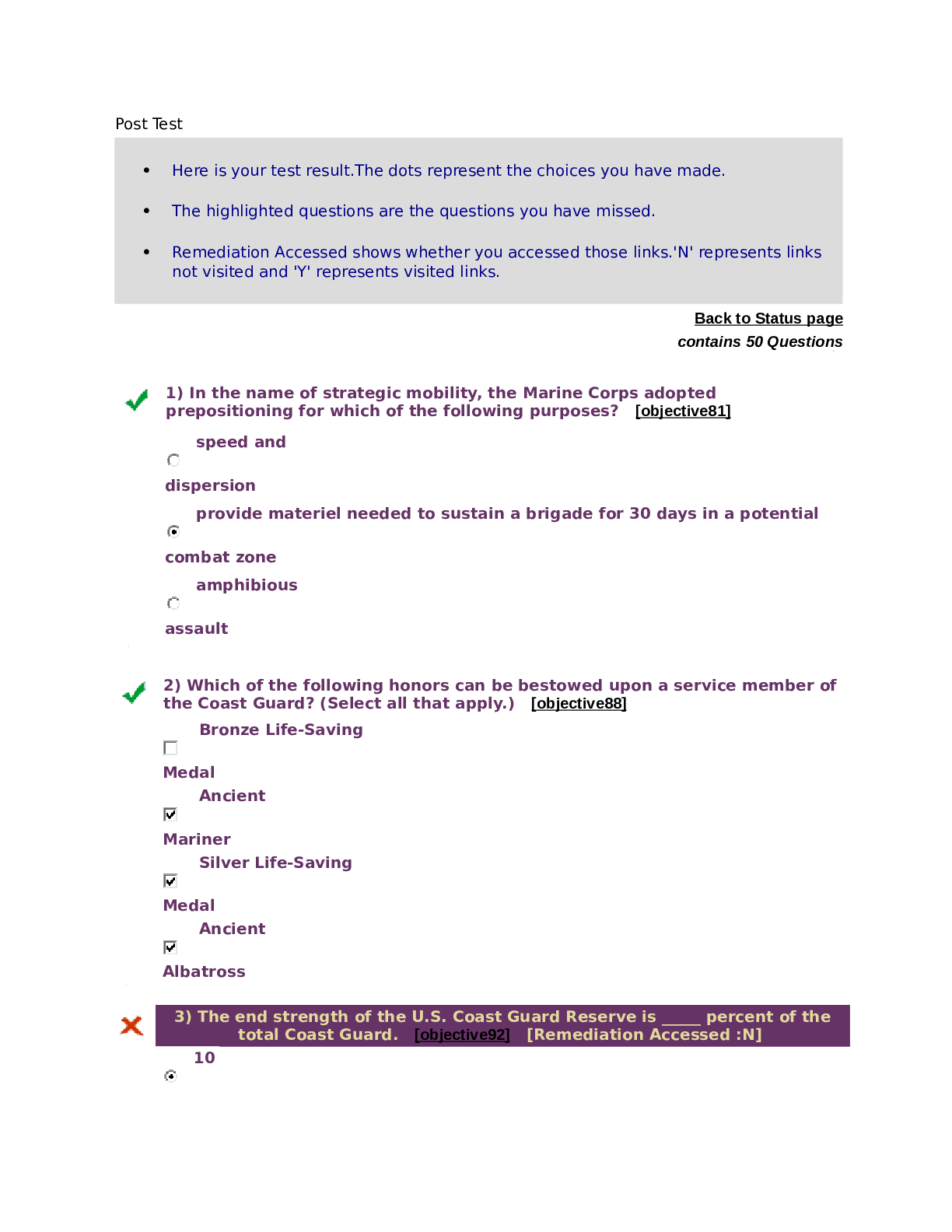
, All Correct, Download to Score A.png)
